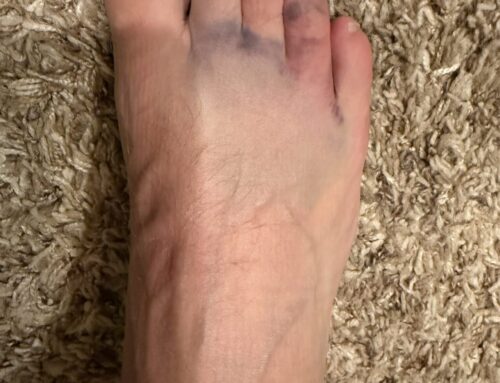If you’re experiencing discomfort in the soles of your feet, you may have plantar fasciitis.
By understanding when to consult a surgeon and the benefits of seeking treatment from a qualified specialist, you can make an informed decision about your care and achieve the best possible outcome for your plantar fasciitis.
Read on!
What Is Plantar Fasciitis and How Is It Treated?
The plantar fascia is a thick band of tissue that connects the heel bone to the toes and becomes inflamed when too much pressure is placed on it. Foot discomfort, especially in the heel and arch, is a common symptom of plantar fasciitis. The plantar fascia helps support the foot’s arch and plays a role in the movement. When it becomes inflamed, it can cause pain and discomfort.
The pain is often the result of overuse or strain on the foot, such as from standing for long periods of time, wearing poorly-fitting shoes, or engaging in high-impact activities. It can also be caused by conditions such as obesity, flat feet, or high arches.
The appropriate surgical procedure will depend on the specific cause and severity of the plantar fasciitis.
Non-Surgical Treatment
There are several non-surgical solutions for this condition, including:
- Rest: Resting the foot and taking a break from activities that cause pain can help reduce inflammation and allow the plantar fascia to heal.
- Ice: Applying ice to the affected area for 15-20 minutes at a time can help reduce inflammation and numb pain.
- Stretching exercises: Stretching the muscles and tendons in the foot and lower leg can help improve flexibility and reduce strain on the plantar fascia.
- Supportive shoes: Wearing shoes with good arch support and a firm heel can help reduce strain on the plantar fascia and reduce pain.
- Orthotic devices: Custom orthotic devices, such as inserts or shoe inserts, can provide additional support for the foot and reduce strain on the plantar fascia.
- Over-the-counter pain medications: Nonsteroidal anti-inflammatory drugs (NSAIDs), such as ibuprofen, can help reduce inflammation and pain.
- Physical therapy: Physical therapy can help stretch and strengthen the muscles in the foot and lower leg, improving flexibility and reducing strain on the plantar fascia.
Overall, non-surgical treatment options for plantar fasciitis are typically effective in relieving pain and improving function. However, in some cases, surgical intervention may be necessary if non-surgical treatments are not effective.
When Is Surgery Necessary for Plantar Fasciitis?
Surgery for plantar fasciitis is generally only recommended when non-surgical treatment options have been unsuccessful in relieving pain and improving function. This may be the case if the plantar fasciitis is severe or if it has been present for an extended period of time without responding to non-surgical treatments.
Before deciding on surgery, it is important to consult with a qualified orthopedic surgeon who specializes in ankle and foot surgery. Your surgeon will evaluate the specific cause and severity of the plantar fasciitis and determine the most appropriate treatment option. In some cases, the surgeon may recommend a combination of non-surgical and surgical treatments.
The Benefits of Surgical Treatment
Some of the potential benefits of plantar fasciitis surgical procedure include:
- Quicker relief of pain: Surgical treatment can often provide quicker relief of pain compared to non-surgical treatments, which can take several weeks or months to be effective.
- Improved function: Surgical treatment can help improve function in the foot and lower leg, allowing for a return to normal activities and exercise.
- Long-term relief: In many cases, surgical treatment can provide long-term relief from plantar fasciitis, whereas non-surgical treatments may only provide temporary relief.
Correction of underlying causes: Surgical treatment can address and correct underlying causes of plantar fasciitis, such as bone spurs or nerve compression, which may not be addressed by non-surgical treatments.
The Different Types of Surgery for Plantar Fasciitis
There are several different types of surgery that can be used to treat plantar fasciitis, including:
- Release of the plantar fascia: This procedure involves releasing the plantar fascia from the heel bone to reduce tension and inflammation. This can be done through traditional open surgery or minimally invasive techniques such as endoscopy.
- Removal of bone spurs: If bone spurs are contributing to plantar fasciitis, they can be removed through surgery to relieve pressure on the plantar fascia.
- Nerve decompression: In some cases, plantar fasciitis may be caused by compression of the nerves in the foot. Nerve decompression surgery can help alleviate this compression and reduce pain.
The appropriate surgical procedure will depend on the specific cause and severity of the plantar fasciitis. It is important to consult with a qualified orthopedic surgeon who specializes in ankle and foot surgery to determine the most appropriate treatment option for your specific needs.
What to Expect During and After Plantar Fasciitis Surgery
Plantar fasciitis surgery is typically performed on an outpatient basis, meaning the patient does not need to stay overnight in the hospital. The specific details of the surgery will depend on the type of procedure being performed.
Before the surgery, the patient will be given general anesthesia to put them to sleep during the procedure. The surgeon will make small incisions in the foot to access the plantar fascia and perform the necessary procedure. Depending on the type of surgery, the incisions may be closed with stitches or left open to heal on their own.
After the surgery, the patient will be taken to a recovery room to be monitored for any adverse reactions to the anesthesia. The patient may experience some pain and swelling after the surgery, which can be managed with medications and ice. The patient may also need to wear a special boot or cast to protect the foot and allow it to heal properly.
Most patients are able to return to normal activities within a few weeks of plantar fasciitis surgery, although it may take several months to fully recover and regain full function in the foot. The specific recovery timeline will depend on the type of surgery and the patient’s individual healing process.
It is important to follow the surgeon’s instructions and attend any prescribed physical therapy sessions to ensure a successful recovery.
Best Place to Get Plantar Fasciitis Treatment
Are you looking for the best place to treat your plantar fasciitis in Boise? If so, then Flint Foot & Ankle should be your go-to choice for quality and excellent care. From our dedicated team of experts to our state-of-the-art facilities, you will get best treatment option in Boise.




